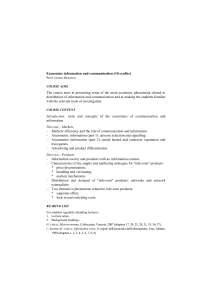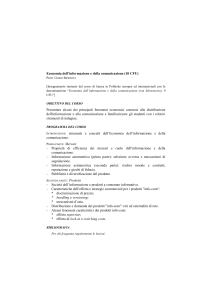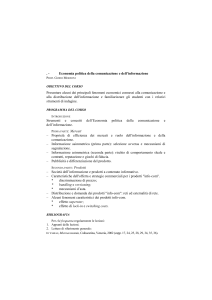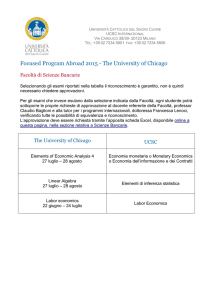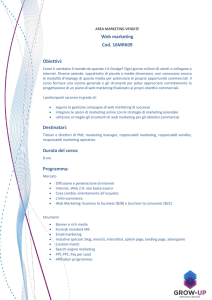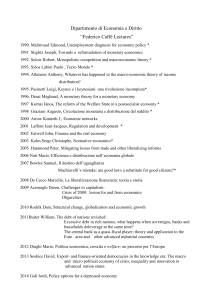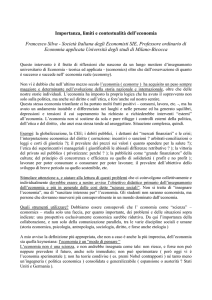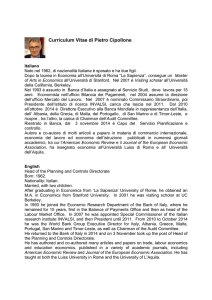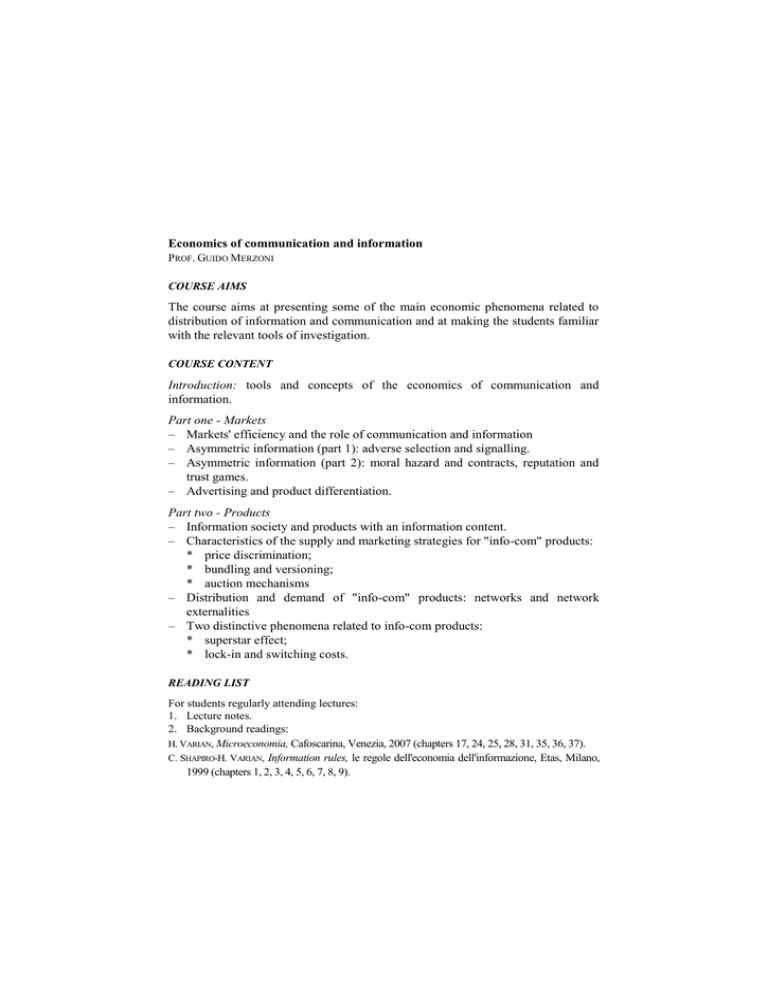
Economics of communication and information
PROF. GUIDO MERZONI
COURSE AIMS
The course aims at presenting some of the main economic phenomena related to
distribution of information and communication and at making the students familiar
with the relevant tools of investigation.
COURSE CONTENT
Introduction: tools and concepts of the economics of communication and
information.
Part one - Markets
– Markets' efficiency and the role of communication and information
– Asymmetric information (part 1): adverse selection and signalling.
– Asymmetric information (part 2): moral hazard and contracts, reputation and
trust games.
– Advertising and product differentiation.
Part two - Products
– Information society and products with an information content.
– Characteristics of the supply and marketing strategies for "info-com" products:
* price discrimination;
* bundling and versioning;
* auction mechanisms
– Distribution and demand of "info-com" products: networks and network
externalities
– Two distinctive phenomena related to info-com products:
* superstar effect;
* lock-in and switching costs.
READING LIST
For students regularly attending lectures:
1. Lecture notes.
2. Background readings:
H. VARIAN, Microeconomia, Cafoscarina, Venezia, 2007 (chapters 17, 24, 25, 28, 31, 35, 36, 37).
C. SHAPIRO-H. VARIAN, Information rules, le regole dell'economia dell'informazione, Etas, Milano,
1999 (chapters 1, 2, 3, 4, 5, 6, 7, 8, 9).
M.A. MAGGIONI-G. MERZONI, L’economia politica e la nuova economia. Fondamenti analitici e
paradigmi interpretativi, in L. PROSPERETTI (a cura di), La New Economy aspetti analitici ed
implicazioni di policy, Il Mulino, Bologna, 2002.
Further bibliographical references and more details concerning the ones above may be
provided during the lectures and published on the course web page.
For students who cannot regularly attend lectures:
1. H. VARIAN, Microeconomia, Cafoscarina, Venezia, 2007 (chapters 17, 24, 25, 28, 31, 35, 36,
37).
2. C. SHAPIRO-H. VARIAN, Information rules, le regole dell'economia dell'informazione, Etas,
Milano, 1999 (chapters 1, 2, 3, 4, 5, 6, 7, 8, 9).
3. M.A. MAGGIONI-G. MERZONI, L’economia politica e la nuova economia. Fondamenti analitici e
paradigmi interpretativi, in L. PROSPERETTI (a cura di), La New Economy aspetti analitici ed
implicazioni di policy, Il Mulino, Bologna, 2002.
4. L. CABRAL, Economia industriale, Carocci, Roma, 2002 (capitolo 13).
5. A. DIXIT-V. NORMAN, Advertising and welfare, Bell Journal of Economics, 9, 1-17, 1978.
6. C. SHAPIRO, Advertising and welfare: comment, Bell Journal of Economics, 11, 749-752, 1980.
7. A. DIXIT-V. NORMAN, Advertising and welfare: another reply, Bell Journal of Economics, 11,
753-754, 1980.
8. S. ROSEN, The Economics of Superstar, American Economic Review, 71, 845-58, 1981
Further bibliographical references and more details concerning the ones above may be
published on the instructor’s web page.
TEACHING METHOD
Lectures and classes. Publication of teaching material on the instructor’s web page.
ASSESSMENT METHOD
The examination may be taken through intermediate written exams or as a single final
written exam on the scheduled date followed by an oral.
NOTES
Students are welcome to contact Prof. Guido Merzoni at the Dipartimento di Economia
Internazionale, delle Istituzioni e dello Sviluppo (Via Necchi, 5, 5th floor) at the times
shown on the notice board at the department and on his personal web page.
Further information can be found on the lecturer's webpage at
http://docenti.unicatt.it/web/searchByName.do?language=ENG or on the Faculty notice
board.

